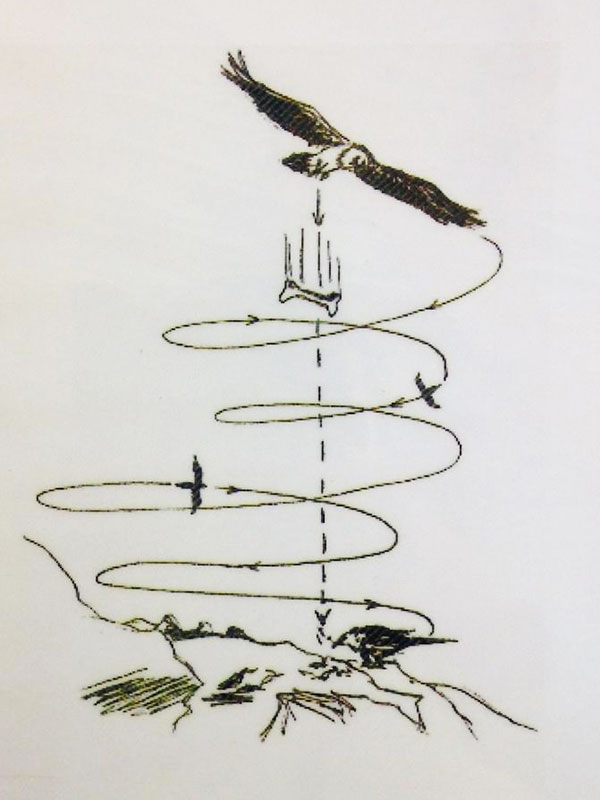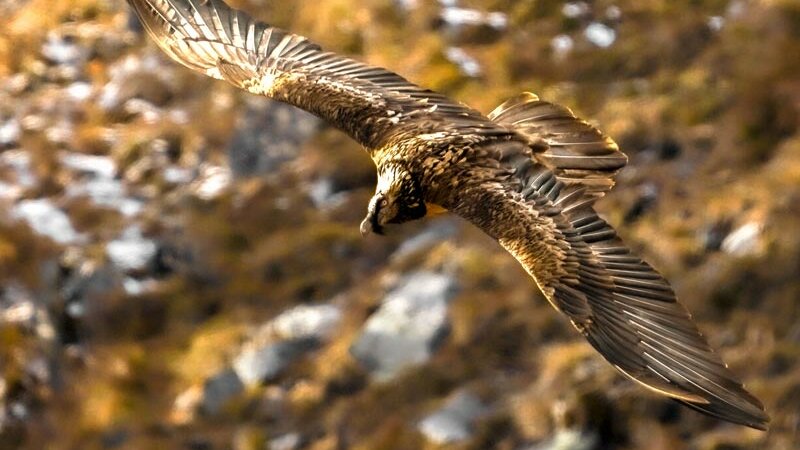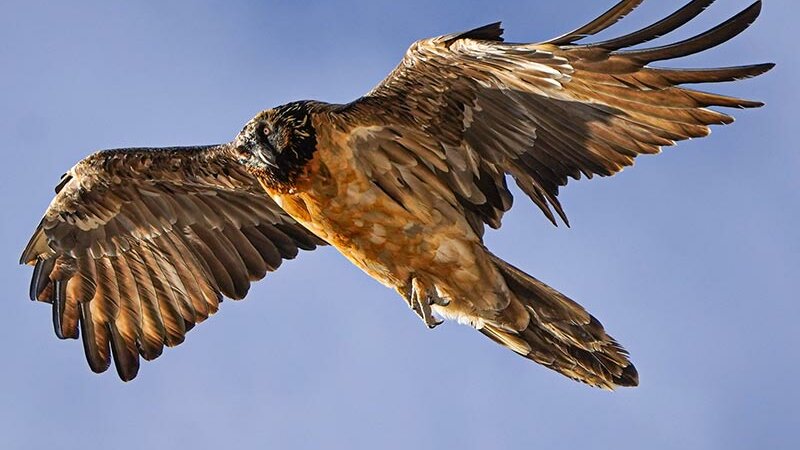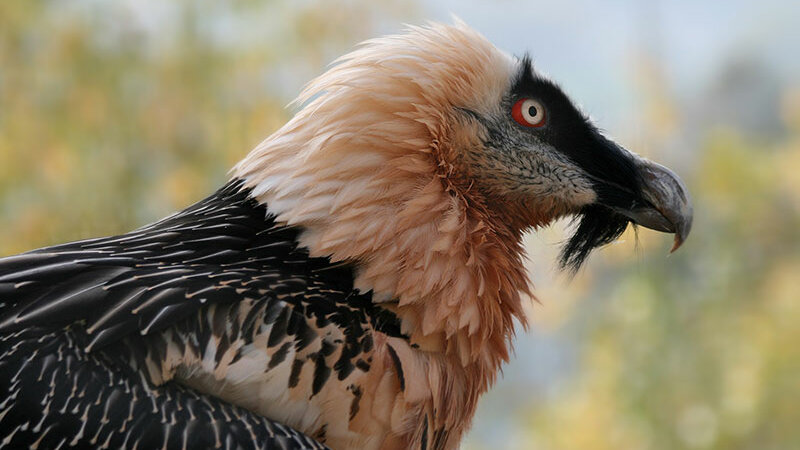A brief profile of the Bearded Vulture (Gypaetus barbatus)

Bearded Vulture Biology
- Weight: 5 - 7 kg
- Wingspan: 2.6m - 2.9m
- Sexual differences: no external differences
- Habitat: Mountains
- Distribution: Europe, Asia and Africa
- Food: Bones
- Mating season: Between November and December
- Egg-laying period: December to February
- Breeding period: Between 52 and 58 days
- First flight: 110 to 130 days after hatching.
- Sexual maturity: Reaches sexual maturity between 5 and 7 years of age
- First successful breeding: average 8 to 9 years
- Reproduction rate: 1 chick every 1 to 2 years
- Life expectancy: Can live up to 50 years in captivity, but life expectancy in the wild is more variable.

A special vulture
As scavengers, vultures play an important role in our ecosystem. They help to ensure that carcasses are quickly removed from the landscape, which in turn limits the spread of disease. As an adaptation to their diet, many vulture species are sparsely feathered on the neck and head to prevent their feathers from sticking together with blood when feeding on fresh carcasses. The Bearded Vulture is the only vulture species that specialises in eating the bones of dead animals. Bearded vultures feed on 80-90% bone. They thus exploit the last part of the carcass that all other scavengers would 'leave behind'. Because the bearded vulture feeds mainly on the bones of dead ungulates, it has a distinctive head and neck plumage, unlike other vulture species.
The digestion of bones is particularly challenging. Although bones contain many nutritious fats and proteins as well as calcium, they are very hard and difficult to digest. Few species are able to digest bones efficiently. With a pH of 0.7, the bearded vulture's gastric juices are extremely acidic. It also has a particularly large beak opening and its trachea reaches almost to the tip of the beak, so it can still get enough air even if a bone gets stuck in its throat.
The bearded vulture's method of dealing with pieces of bone too large to swallow is particularly fascinating. They will carry it high up into the sky and drop it onto rocks below. This helps break up the bones into smaller, ingestible pieces. Although this is an innate skill, it must be diligently practiced and perfected as the bird grows.
Where does its name come from?
The bearded vulture is known by many names, reflecting its particular diet in different languages. In Tyrol it is often called "Boanbrüchl", while in Spain it is known as "Quebrantahuesos" - which means "bone breaker". In English the term "Lammergeyer" is often used. The name "Lammergeyer" used to be common in German-speaking countries, based on the misconception that these majestic birds prey on lambs. Today, however, the name "Bearded Vulture" has become more common, named after the distinctive dark beard that adorns the head of both males and females.
![[Translate to en:] Illustration Bartgeier ©Maria Weninger [Translate to en:] Illustration Bartgeier ©Maria Weninger](https://www.naturpark-oetztal.at/fileadmin/userdaten/Bilder/galerie_800x600px/tiere/Voegel/bartgeier/illustration_bartgeier_maria_weninger.jpg)
![[Translate to en:] Bartgeier ©Stefan Plangger [Translate to en:] Bartgeier ©Stefan Plangger](https://www.naturpark-oetztal.at/fileadmin/userdaten/Bilder/galerie_800x600px/tiere/Voegel/bartgeier/bartgeier5_c_stefan_plangger.jpg)
Breeding and lifespan
Bearded vultures are considered sexually mature at 5 to 7 years of age. The first successful breeding usually takes place at the age of 8 to 9 years. A breeding pair can raise a maximum of one chick per breeding season, meaning that bearded vultures reproduce very slowly. Bearded vultures can live to an advanced age of 40-50 years in zoos and over 30 years in the wild. However, various threats, including human impact, can rapidly increase mortality rates and threaten the long-term survival of bearded vultures.
Bearded vultures typically lay two eggs per breeding season, although they can only successfully rear one young. These eggs are laid about a week apart, meaning that the young hatch at different times and are of different sizes. In fierce competition for food, the stronger chick will often displace the weaker one in the first few days of life, tragically resulting in death. This behaviour is known as "Cainism", a reference to the biblical story of Cain and Abel in the Old Testament. The parents find foraging extremely costly and can only provide enough food for one chick. The second egg serves as a biological reserve in case the first egg is not fertilised, the embryo dies or the older chick does not survive the first few days.
Breeding season
Bearded vultures in the Alps begin breeding between December and February. This unusual timing is related to the diet of the chicks. They are unable to digest bones in the first few weeks of life, so they rely on fresh muscle meat. The incubation period is about 55 days, so the chicks hatch towards the end of winter. By this time, there are enough carcasses of animals that have not survived the harsh winter conditions for the bearded vulture parents to provide fresh meat for their chicks.
After about 110 to 130 days, the young bird takes its first flight. At first it stays close to the nest and improves its flying skills. During this time it is often accompanied by its parents until its childhood ends at the age of 8 months and it usually leaves its parents' territory.
![[Translate to en:] Bartgeier ©Elisabeth Weninger [Translate to en:] Bartgeier ©Elisabeth Weninger](https://www.naturpark-oetztal.at/fileadmin/userdaten/Bilder/galerie_800x600px/tiere/Voegel/bartgeier/bartgeier_c_elisabeth_weninger.jpg)












